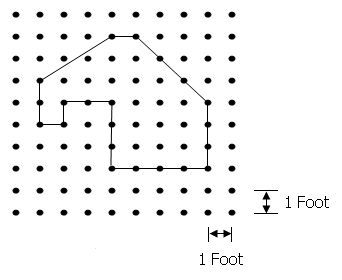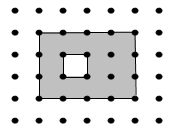Pick’s Theorem is a simple way to calculate area. This theorem is particularly useful when calculating the reduction of square feet (or square meters) that was achieved by improving a process layout. To use Pick’s Theorem, overlay a sketch of the area that you want to calculate onto a square grid of points. The grid of points should be fine enough that any bend on the boundary coincides with a grid point. For example:  To calculate the area, simply take the sum of the number of points on the boundary divided by two, plus the number of interior points minus one. Or, in shorthand: A = ½ B + I -1 For the above example, the number of boundary points is 21, and the number of interior points is 17. Therefore, the area is: A = ½ 21 + 17 – 1 = 26.5 sq. ft. This method is exact, but it's not always necessary. Don't forget that in many cases you can get an accurate estimate of floor space by simply counting the number of floor tiles (or ceiling tiles) and multiplying by the area of each tile. This method is fast, easy, and often accurate enough for most situations. And, a word of caution. Pick’s Theorem works for lattice polygons, but breaks down if there are any holes in the lattice polygon. For example, in the shaded figure below the number of boundary points is 18, there are 2 interior points, so using Pick’s Theorem the area works out to be 10 sq units. But clearly the actual area is 11 sq. units! The issue is the hole.
To calculate the area, simply take the sum of the number of points on the boundary divided by two, plus the number of interior points minus one. Or, in shorthand: A = ½ B + I -1 For the above example, the number of boundary points is 21, and the number of interior points is 17. Therefore, the area is: A = ½ 21 + 17 – 1 = 26.5 sq. ft. This method is exact, but it's not always necessary. Don't forget that in many cases you can get an accurate estimate of floor space by simply counting the number of floor tiles (or ceiling tiles) and multiplying by the area of each tile. This method is fast, easy, and often accurate enough for most situations. And, a word of caution. Pick’s Theorem works for lattice polygons, but breaks down if there are any holes in the lattice polygon. For example, in the shaded figure below the number of boundary points is 18, there are 2 interior points, so using Pick’s Theorem the area works out to be 10 sq units. But clearly the actual area is 11 sq. units! The issue is the hole.  For cases like these, we recommend calculating the total area without the holes and then subtracting the area of the holes.
For cases like these, we recommend calculating the total area without the holes and then subtracting the area of the holes.
Pick's Theorem (or Pick an Area, Any Area)
Blog contents Copyright ©2009-2024 Mark R. Hamel. The views expressed herein are solely personal views and not those of associates, clients or employers. Comment functionality has been deactivated. Please contact [email protected] with any questions or comments.
